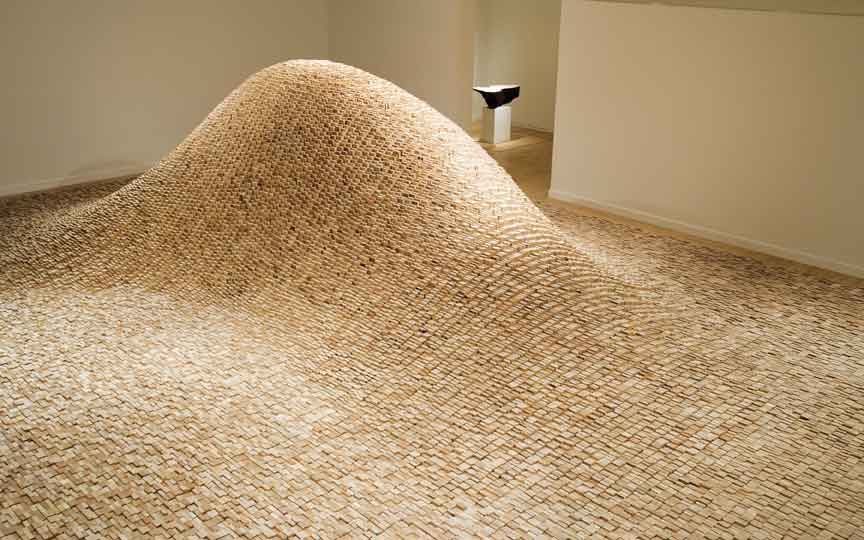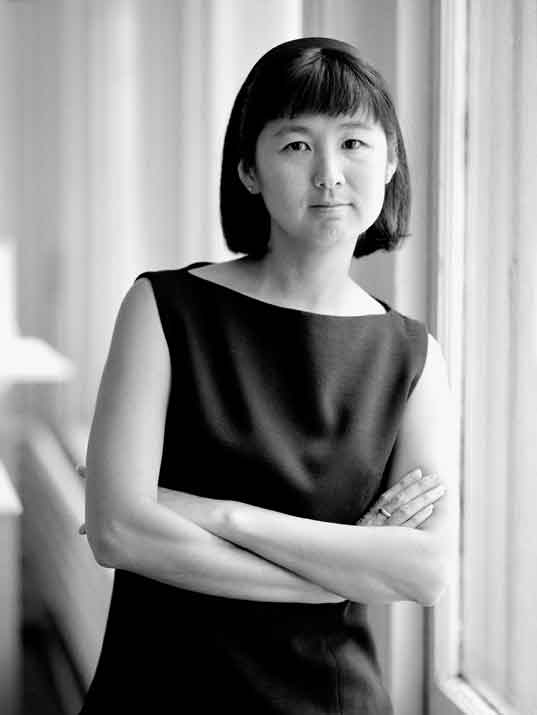« Features
Maya Lin: A History of Water
By Suzanne Cohen
The Orlando Museum of Art is exhibiting until May 10th an exhibition that brings together Maya Lin’s sculptures, drawings and large-scale installations, as well as her multimedia memorial to the earth’s vanishing biodiversity and habitats. These works resonate with her deep regard for the natural world, while revealing a creative practice that is informed by close observation, research and scientific data.

Maya Lin, Water Line, 2006, aluminum tubing and paint, 19’ x 30’ x 34’ 9.” All images are courtesy of the artist and Pace Gallery, New York.
Maya Lin (born 1959, Athens, Ohio) graduated cum laude from Yale University, earning a Bachelor of Arts degree in 1981 and a Master of Architecture degree in 1986, and as a professional she has struck a careful balance between art and architectural design. Her works of expressive beauty challenge viewers to see the world in new ways and reconsider their relationship to the environment.
Landscape, global geography and the earth’s ecology are central concerns of her art. Within the broad scope of these themes, water has been a particular focus of ideas expressed in Lin’s work. This exhibition presents sculptures and drawings she has created since 2006 that address aspects of water ranging from its seductive visual appeal to its critical importance to natural and developed environments worldwide. Her work includes references to maps of Hurricane Sandy’s storm surge, networks of waterways that comprise the world’s great rivers, shrinking contours of endangered bodies of water, hidden undersea topography, permeable boundaries between land and water, and dynamic wave forms.
These pieces often reveal features of the natural world that individuals cannot easily see because of their geographic size or because they are concealed underwater. By reducing the scale of a river system, isolating a sea from its surrounding topography or removing an ocean to view undersea terrain, Lin provides new ways to understand these entities. Her series of Silver Rivers and Pin Rivers present vast waterways on a gallery wall so they can be viewed as a comprehensive whole. Similarly, her Bodies of Water series presents enormous lakes and inland seas as three dimensional objects, lifted out of the landscape and set on pedestals to allow viewers to examine them above and below the water’s surface.
Pin River, Kissimmee, brings attention to a river currently undergoing a major restoration of its historic course. In the 1960s, the Kissimmee River was made into a straight channel with devastating environmental consequences. Lin uses thousands of straight pins pushed directly into the gallery wall to map the river’s original meandering course through Central Florida to Lake Okeechobee. The dense multitude of pins illustrates the river’s complex winding shape. The open arrangement of the pins further suggests the river’s permeable banks that allow its overflow to nourish surrounding wetlands and support an abundance of Florida wildlife.
It is the good approach prescription de viagra canada http://www.fundacionvision.org.pa/flashxml/bannerrotatorfx/BannerRotatorFX.swf for overcoming erectile dysfunction. The main motive fundacionvision.org.pa buy viagra in stores of these meds is improving male sexual performance or enhancing male power during intimate moments. This ingredient is a PDE find out for more info now generic levitra online 5 inhibitor, thus, it works to inhibit the PDE 5 enzymes (a cause of ED) and enhancing the cyclic GMP (erection providing enzyme). If the level of this hormone buy cialis online goes low, it should be done very cautiously.
Three works in this exhibition, Water Line, Flow and 2×4 Landscape, are room-sized sculptural installations that create dramatic physical and psychological encounters for the viewer. Water Line is an immersive three-dimensional drawing that visitors can enter and explore. The lines, made with thin aluminum elements suspended in the gallery, depict the contours of immense mountains that rise from the ocean floor in the remote South Atlantic. Flow and 2×4 Landscape are each made with thousands of two-by-four boards assembled with their cut ends up. The flat, rectangular ends have the appearance of pixel-like data points that collectively become monumental physical forms. Flow represents a succession of waves that progressively rise and dissipate over a span of 35 feet. 2×4 Landscape is an immense, 2,400-square-foot mound that rises to a height of 10 feet and can be interpreted as a hill or wave.
Lin examines the natural world through the lenses of 21st-century science and technology. Each of her pieces begins with extensive research that may include complex scientific data provided by sources such as remote satellite-sensing imagery and sonar resonance scanning. Her work merges this systematic and technological interpretation of the world with her chosen sculptural materials by what she calls a “purely intuited gesture.”
“It’s a process that balances scientific data with the handmade,” she says. “If the end form only looks like the idea of information, it fails. It has to become its own form–evocative, beautiful and strange.”

Maya Lin, Red Sea (Bodies of Water series), 2006, Baltic birch plywood, edition 2/3, sculpture: 21” x 92 ½” x 17,” base: 31” x 30” x 18.”
Lin’s studio artwork has been the subject of solo exhibitions at museums worldwide including the Wexner Center for the Arts in Columbus, Ohio; American Academy in Rome, Italy; Wanås Foundation in Kinslinge, Sweden; and Carnegie Museum of Art in Pittsburgh, Penn. A major touring exhibition, “Systematic Landscapes,“ was presented at the Henry Art Gallery in Seattle; Contemporary Art Museum in St. Louis; Museum of Contemporary Art in San Diego; de Young Museum in San Francisco; and Corcoran Museum of Art in Washington, D.C. She has created permanent outdoor installations for numerous public and private collections, including the California Academy of Science in San Francisco (San Francisco Arts Commission for the Civic Art Collection); Wanås Foundation; Wexner Center for the Arts; Storm King Art Center in Mountainville, N.Y.; and her largest earthwork to date, Fold in the Field, is at Gibbs Farm in Kaipara Harbour, New Zealand.
She has been drawn to the critical social and historical issues of our time and addressed them in her memorials, including at the Vietnam Veterans Memorial in Washington, D.C.; the Civil Rights Memorial in Montgomery, Ala.; and The Women’s Table at Yale University in New Haven, Conn. Currently she is working on the Confluence Project, a multi-sited installation spanning the Columbia River system in the Pacific Northwest that intertwines the history of Lewis and Clark with the history of the Native American tribes who inhabit those regions.
“Maya Lin: A History of Water” is on view through May 10 at Orlando Museum of Art | 2416 N. Mills Ave. Orlando, FL 32803 | www.omart.org.
Suzanne Cohen is an arts writer based in Orlando, Fla.


















